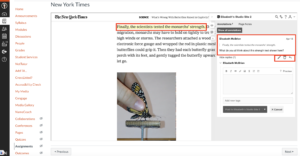One of my favorite design strategies is to make a small adjustment that delivers a big impact. When it comes to creating a welcoming online course, certain small adjustments can do just that and go a long way in warming up the online classroom. But first, let us look at why online courses ought to be welcoming and then what it means to be welcoming in the online space.
Why Welcoming Students Is Important
First, why is it important to design a welcoming course? According to the OSU Ecampus Online Teaching Principles, which are supported by research and endorsed by Quality Matters, it is recommended to “[m]ake facilitation choices that support diverse students and make each student feel welcomed and valued.” Additionally, specific review standard 1.8 from the Quality Matters Higher Education Rubric, 7th Edition, states that “The self-introduction by the instructor is welcoming and is available in the course site.” Furthermore, UDL 3.0 Guidelines were updated recently and include “Design Options for Welcoming Interests & Identities.” While all of those are evidence-based recommendations, I think it is safe to say that many faculty also have plenty of anecdotal evidence for the benefits to students when feeling welcome in a course. If one has been working in the higher education context for several years, it is easy to forget that many students struggle to feel that they belong in this context. Warm communication and greetings is one way to begin connecting with students who are skeptical that their experience matters or that their presence is valued.
What Does It Mean To Be Welcoming?
Next, let’s look at what it means to be welcoming in the online classroom. If we get down to basics and turn to a dictionary definition, we see that Merriam-Webster has defined welcoming as “to greet hospitably and with courtesy and cordiality; to accept with pleasure the occurrence or presence of.” For the online modality then, we can ask ourselves some questions: Where in the course can facilitators greet students? When students inquire about office hours or email with a question, can their presence be warmly accepted? Next let’s look at actions that faculty or other course facilitators, such as graduate teaching assistants, can take to be welcoming.
Creating a Welcoming Online Classroom
The following tips are just a few of the actions that can be taken to create a welcoming online classroom:
- Greet each student in the introduction discussion. Replying to each student is one of those actions that is small but has a big impact.
- Many online students are older than the traditional college age, so they often have extensive work experience and life experiences to draw upon. Acknowledging this life experience can go a long way in welcoming students.
- Rename office hours to something like Coffee Chat, Afternoon Tea, or Q&A Hour. Here is an example to consider: Which description of office hours sounds more welcoming, Example 1 or Example 2? Example 1: “Office Hours are held by appointment. Please email to make an appointment.” Let’s compare that to Example 2: “Please join me for a Coffee Chat this term! Coffee Chats are held three times per term, as an open Zoom room for our class. If you can’t attend any of the scheduled Coffee Chats, please email me and schedule a time to meet. I want to get to know each of you. Furthermore, when I get to know students, I am better positioned to serve as a reference for educational or professional opportunities that come up in our field. I look forward to meeting with you!”
- Consider how students are described in the course site. Alternative descriptions besides “students” could be fellow scholars, colleagues, participants, etc.
- Consider these two different introduction discussion prompt designs, 1 and 2:
- Design 1: “Students: Post an introduction that includes the following: Your major and why you are taking this course. Reply to two other students.”
- Design 2 (designed to be more welcoming): “Welcome, fellow engineering scholars! Please introduce yourselves so that we may all begin to get to know each other. In your post, include 1) an educational or professional goal that you have connected to this course, 2) a time management tip that you have found helpful that you are willing to share with others, and 3) a photo or fun fact about yourself. Replies to other participants are optional but encouraged.”
- Consider these two different introduction discussion prompt designs, 1 and 2:
- Ecampus Online Teaching Principles, endorsed by Quality Matters, recommend “referring to each student by name with their chosen pronouns.” Sometimes students who use a shortened nickname will say so in their introductory post, but it is also nice to include instructions for students on how to change their display name in the course site. That way, facilitators of the course, including graduate teaching assistants, if applicable, do not have to refer back to the introduction post to remember what students prefer to be called.
Takeaway
Adding a welcoming tone to a course does not mean that the whole course needs to be redesigned. A few small adjustments here and there can make a difference.
Recommended Readings for Further Interest
- Marshall, S. (2023). But What Does it Look Like in Maths? A Framework for Culturally Sustaining Pedagogy in Mathematics. International Journal of Multicultural Education, 25(1), 1-29.
- Price, J., & Fox, A. (2023). Transformative Praxis: A Critical Design Framework for Belonging and Inclusion in Technology-Rich Learning Spaces. Journal of Teaching and Learning with Technology, 12, 55-71.
- Creating a welcoming classroom, UMBC Faculty Development Center.
- Shaping a Positive Learning Environment, Ohio State University Teaching and Learning Resource Center.





